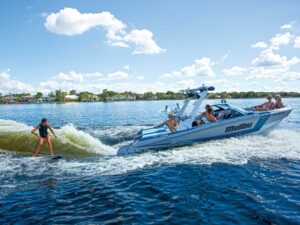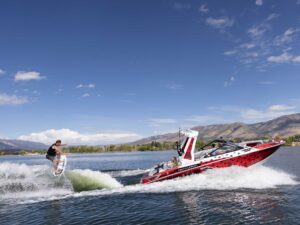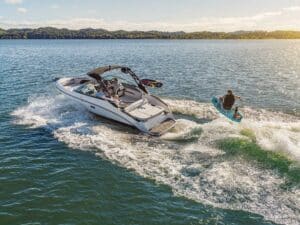“Add some depth!” Take out 3/1000 tip!” Move the blade back a little!” Fin adjustment technical jargon can be heard on any ski lake if there are “slalom tweakers” on the water. The problem is, if you don’t know what you’re doing, you may end up “in the drink” early in your next set. Here are four keys to success when making a fin change.
Know What You’re Looking For
Don’t expect fin adjustments to fix all of your problems. You want these adjustments to make the ski feel ideal, but accept the fact that your technique may still need some work. An ideal ski setup should yield plenty of controlled acceleration, freedom in the edge change and stability throughout the turn.
Know When to Say When
Again, don’t expect the adjustments to solve all of your problems. Just because you don’t ski a personal best every time you ski, that doesn’t mean you need to keep making adjustments. Once you get the ski dialed in and have a couple of good sets on it with settings that feel nice, stick with it — don’t keep tweaking!
Know Balance
The important thing is to balance all of the characteristics you are seeking. Too much of a fin tweak one way can be detrimental to your performance. For example, you want the ski to turn well, but you also want to be able to handle the load out of the turn and make it to the next buoy. Any fin adjustment that is too extreme can result in a beat-up-body.
Know What the Basic Fin Movements Do
Here is a rundown of how different aspects of your fin settings affect your ski’s performance.
• Depth: Measurement of the fin at its deepest point. A deeper fin will give the ski stability and allow it to track well. A shallower fin will allow the tail of the ski to slide more readily through turns, but may not allow the skier to hold all of the angle through the wakes.
• Length: Measurement of the fin exposed at the bottom of the ski. A longer fin will initiate the turn more readily, but may hinder your ability to ski outbound after the second wake. A shorter fin will allow you to carry your outbound direction better, but may not help the tip of the ski drop in to initiate the turn.
• Distance from the Tail: Measurement from the tail of the ski to the back of the fin. When the fin is very close to the tail of the ski, the ride will feel more stable. You will be able to hold more angle the farther back the fin is, but it may become difficult to turn if you go too far back. If the fin is moved forward of its stock setting, the ski will finish the turn very handily, but sometimes too aggressively. If the ski finishes the turn too aggressively, you may look like a champ to your nonskiing friends, but you may come up short for the next buoy since you won’t be able to hold all of the angle.
• Wing: Most skis have an adjustable wing attached to the fin. More angle on the wing will create stability, but also creates a little drag that can be counterproductive to acceleration across the wakes. If you do not have enough angle on the wing, the ski may feel a little unstable and unpredictable.
Common Fin-Tweaker Questions:
Am I good enough even to worry about the fin setup?
It is true that small fin adjustments are more noticeable to higher-end skiers, but all skis need to be set up properly to perform well for any level of skier. A poorly set up ski can definitely hinder the progress of a skier at any level.
AdvertisementWhy should I only make one fin adjustment at a time?
If you make more than one fin adjustment at a time, you may never gain a full understanding of what each movement does to your ski. Just as in a science experiment, there is a control and a variable — but more than one variable can create worthless data.
Do I really need a wing?
On most skis designed after 2002, a wing is commonplace. True, the wing does create a little drag on the ski, but it is more obviously associated with the stability of the ride: It allows the ski to track much more predictably and finish the turn with a greater amount of control.
Seth Stisher, the head slalom coach of H2Osmosis at Trophy Lakes, can be reached at 866-213-7993 for instruction.









